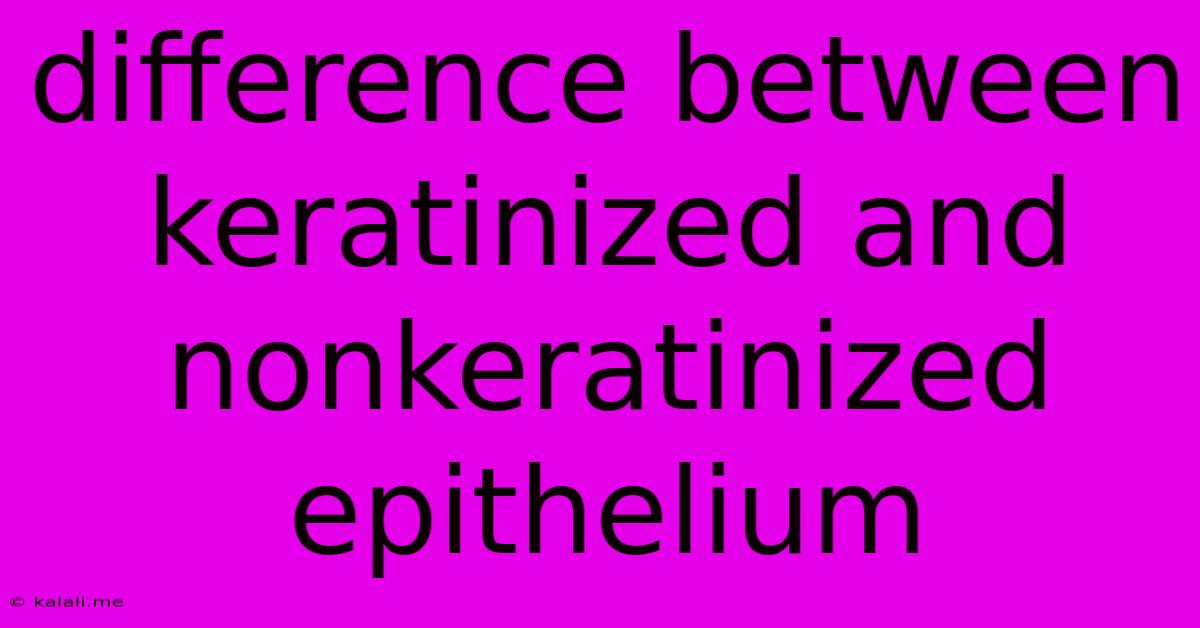Difference Between Keratinized And Nonkeratinized Epithelium
Kalali
Jun 16, 2025 · 3 min read

Table of Contents
Keratinized vs. Nonkeratinized Epithelium: A Comprehensive Comparison
Epithelial tissue, a fundamental component of our bodies, forms a protective barrier covering external surfaces and lining internal cavities. Within this tissue type exists a crucial distinction: keratinized versus non-keratinized epithelium. Understanding this difference is key to appreciating the diverse functions of epithelial tissue and its role in maintaining overall health. This article will delve into the key distinctions, locations, and functions of these two epithelial types.
What is Keratinization?
Keratinization is a process where epithelial cells produce and accumulate keratin, a tough, fibrous protein. This process significantly strengthens and waterproofs the epithelium, making it resistant to abrasion, dehydration, and microbial invasion. The degree of keratinization varies, ranging from lightly keratinized to heavily keratinized.
Keratinized Epithelium: Structure and Function
Keratinized epithelium is characterized by a thick, superficial layer of dead, flattened cells packed with keratin. These cells are essentially bags of keratin, devoid of nuclei and organelles. This structure creates a formidable barrier:
-
Location: Found primarily in areas subjected to significant friction and abrasion, such as the epidermis (outer layer of skin), providing protection against environmental stressors. It’s also present in the hard palate of the mouth.
-
Function: Its primary function is protection. The keratin layer shields underlying tissues from mechanical damage, dehydration, and pathogen entry. It acts as a physical barrier, preventing water loss and maintaining homeostasis. Think of it as the body's natural armor against external threats.
-
Layers: Keratinized epithelium is stratified, meaning it's composed of multiple layers of cells. This includes the stratum corneum (the outermost, keratinized layer), stratum lucidum (only in thick skin), stratum granulosum, stratum spinosum, and stratum basale (the deepest layer). Each layer contributes to the overall protective function.
-
Examples: The epidermis of the skin is the most prominent example. The thick skin found on the palms of the hands and soles of the feet represents the most heavily keratinized epithelium.
Non-Keratinized Epithelium: Structure and Function
In contrast to its keratinized counterpart, non-keratinized epithelium lacks the thick layer of dead, keratinized cells. Instead, it is composed of living cells that retain their nuclei and organelles. This results in a more pliable and moist epithelium.
-
Location: This type of epithelium is found in areas requiring flexibility and permeability, such as the lining of the oral cavity (except the hard palate), esophagus, conjunctiva of the eye, and vagina.
-
Function: While still providing protection, its primary function is more focused on facilitating absorption, secretion, and diffusion. Its moist surface allows for easier passage of substances. The lack of keratin allows for flexibility and adaptability to the constantly changing environment within these areas.
-
Layers: Similar to keratinized epithelium, non-keratinized epithelium is typically stratified, though the layers are less defined. The lack of keratinization means that cells remain alive throughout all layers.
-
Examples: The lining of the esophagus, the inner lining of the cheeks, and the lining of the cornea are prime examples.
Key Differences Summarized:
| Feature | Keratinized Epithelium | Non-keratinized Epithelium |
|---|---|---|
| Keratin | Present, abundant | Absent |
| Cell Nuclei | Absent in superficial layers | Present in all layers |
| Surface | Dry, tough, resistant to abrasion | Moist, flexible, permeable |
| Location | Epidermis (skin), hard palate | Oral mucosa (except hard palate), esophagus, vagina |
| Function | Protection against abrasion & dehydration | Protection, absorption, secretion, diffusion |
Conclusion:
The difference between keratinized and non-keratinized epithelium lies primarily in the presence and abundance of keratin. This seemingly simple distinction has profound implications for the structure, function, and location of these tissues. Understanding these differences is crucial for comprehending the diverse roles epithelial tissues play in maintaining the integrity and health of our bodies. This knowledge is vital in various fields like medicine, dentistry, and biology.
Latest Posts
Latest Posts
-
How To Create Clickable Image In Html
Jun 16, 2025
-
What Are The Factors Of 121
Jun 16, 2025
-
What Is A Theme Of The Passage
Jun 16, 2025
-
A Company That Provides Access To The Internet
Jun 16, 2025
-
Which Word Is Closest In Meaning To The Underlined Word
Jun 16, 2025
Related Post
Thank you for visiting our website which covers about Difference Between Keratinized And Nonkeratinized Epithelium . We hope the information provided has been useful to you. Feel free to contact us if you have any questions or need further assistance. See you next time and don't miss to bookmark.